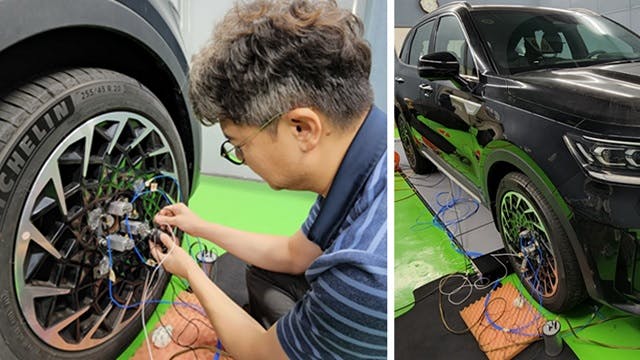Road noise is the most dominant noise source in almost all driving conditions of an electric vehicle. What if you could improve vehicle comfort by predicting the noise, vibration, and harshness (NVH) performance of a virtually assembled vehicle at any stage during development?
In this webinar, Katleen Michiels from Siemens Simcenter and Sangyoung Park from Hyundai Motor Group (HMG) explains how to use a test-data-driven MBSE approach to accurately predict road noise, focusing on the vehicle body, suspension, and tire. Register to watch now.
Predict the NVH performance of a virtually assembled vehicle at any stage in the development
Without the masking of a combustion engine, sound from the road is more prominent in electric vehicles (EV) and has become the dominant source of noise for drivers and passengers. Yet, road noise prediction is notoriously difficult and has become one of the critical issues facing engineers working on EVs. In this webinar, you will learn how to address the challenges early in development by:
- Using advanced road noise prediction technologies to represent the tire, suspension, and body
- Virtually predict NVH performance using a model-based sub structuring approach
- Developing a roadmap for building a digital twin of road noise refinement in HMG
Use a test-data-driven MBSE approach to accurately predict road noise
To predict road noise, it is essential to combine simulation, testing and engineering expertise. And hence, deploying proven NVH technologies.
- Component-based transfer path analysis (TPA) technology at the wheel level to determine invariant wheel center loads. These invariant loads, sometimes referred to as blocked forces, are solely dependent on the wheels, invariant to the receiving structure.
- Frequency-based substructuring (FBS) decoupling to accurately represent the subsystem in its realistic operational boundary conditions and preload. Using this methodology can characterize the vibrational behavior of an unknown component by subtracting the supporting structure from the complete assembly.
- Virtual prototype assembly (VPA) to enable vehicle NVH prediction at any stage during the development by assessing the NVH levels at the target locations from virtually assembling a vehicle prototype.
- Vehicle sound simulator to create a full digital twin of a vehicle under development and listen and/or feel its behavior long before its physical prototype.
Develop a roadmap for building a digital twin of road noise refinement
Join the webinar to learn about HMG's methods, results, and achievements of their NVH vehicle model project, the cooperation with Siemens, and their roadmap for EV road noise refinement. We will explain the challenges of building good vehicle models, describe CAE & test-based component representation, and demonstrate how to define invariant loads. You will learn how to handle and model strongly coupled sources in the vehicle and with which tools one can easily replace one component or subsystem with an alternative version.
Meet the speakers
.jpg?auto=format,compress)
Katleen Michiels
Team Manager Simcenter Engineering
With more than 25 years of NVH engineering experience, Katleen Michiels worked in various roles in support, project engineering, and program management. In her current role as Test Team manager at Simcenter Engineering services, she supervises customer projects and takes up an advisory role for NVH testing and simulation solutions. Katleen helps OEMs and suppliers with NVH projects such as troubleshooting or target setting, multi-attribute optimization, vehicle modeling for performance prediction, roadmap development, early-stage prediction, and road noise refinement in hybrid and electric vehicle development.
.jpg?auto=format,compress)
Sangyoung Park
Senior Research Engineer
Sangyoung Park has been NVH test engineer in HMG for almost 25 years and was involved in developing passenger vehicles such as Santa Fe, Sonata, Avante, and the next-generation platform. He played a crucial role in applying ANC and ASD technology to HMG's vehicles and assessing sound quality performance during vehicle development. During the past four years, Sangyoung developed and applied sophisticated test technologies for realizing model-based virtual development of the Digital Engineering Center. Its mission is to drive digital transformation with a three-pillar strategy: Data, Process, and Virtual.



